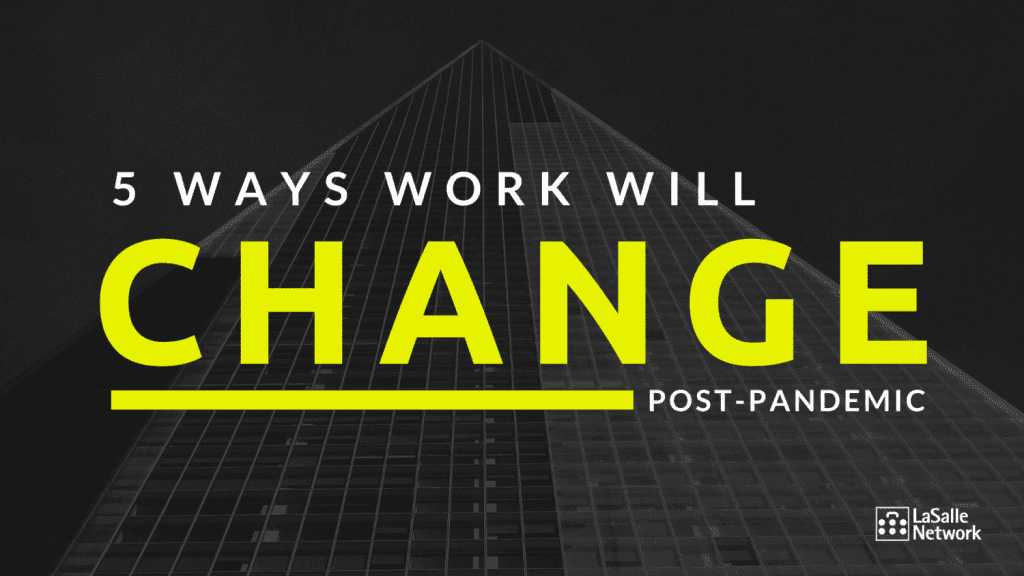As states across the country slowly begin to reopen, organizations have begun to consider how they will bring their workforce back to the physical office, and what the new normal of work will look like in the wake of COVID-19.
The emergence of COVID-19 has forced once-bustling offices to disperse, leaving employers to adapt to remote work and altered ways of doing business, with little time to prepare.
It’s now becoming increasingly clear which elements of this new way of work will remain as we re-open businesses, and which elements the pandemic has drastically altered.
Continued Remote Work
Employees worldwide are currently carrying out what Bloomberg has dubbed “the world’s largest work–from–home experiment,” which could continue well after the restrictions from the pandemic have been lifted. A recent Gallup poll of American workers revealed that 62% are working from home during the COVID-19 pandemic, and 3 in 5 of those workers would elect to continue working from home once the limitations of the pandemic are lifted. It is likely that employees will begin to divide the time between working in the office and at home to limit the amount of people gathering in close, regular contact with one another in the workspace.
To save money, companies around the world have begun renegotiating leases on offices that have been unused for the last several months and seeing about leasing smaller spaces with now being comfortable keeping some staff remote. In fact, a Gartner survey that polled 317 CFOs in late March 2020 revealed that 17% of respondents are planning to move at least 20% of their workforce to permanently remote positions.
Managers will need to consider how remote work in the post-pandemic era will affect their teams and future operations, if some members are remote and others come back to the office. Elements like team-building events or collaborative projects that typically would be done in-person, will look different, adding a host of new challenges to the mix. Organizations that previously did not permit remote work may be forced to reconsider, as data from the University of Chicago revealed that 37% of jobs in the U.S. could be carried out remotely, opening the door to the possibility of continued increased remote work rates across all industries. When the economy is back running at full steam, companies may have to consider offering remote work if it’s what talent wants when it flips back to a candidate-driven market in the future.
Office Layouts
With no vaccine for COVID-19 available for public consumption, workplaces will likely need to impose new elements into their offices to help protect their employees’ health, and to mitigate outbreaks. While some experts are speculating the end of the “open–office” layout post-pandemic because of its various health hazards, others are recommending less drastic measures employers can take to reconfigure their offices. However, needless to say – offices of the future will look different. From plexiglass sheets, desks reconfigured to allow for 6 feet of separation, shifts for communal bathroom uses, dedicated office entrances and exits, temperature checkers at entrances, removal of common seating areas – the layout of offices will change. It’s important that as employers begin re-entry plans, they communicate this new way of work to employees early and often because what they were used to may no longer exist.
In-person Interaction
“I don’t think we should ever shake hands ever again,” said Dr. Anthony Fauci, Director of the National Institute of Allergy and Infectious Diseases. While the cultural act of the handshake is unlikely to vanish from business forever, this message highlights the drastic change in-person business is likely to endure in the wake of the COVID-19 pandemic.
In cooperation with more rigorous health practices in the workplace, regular gatherings of employees in confined conference rooms may be forbidden if 6-ft separation measures can’t be upheld. Also, non-essential business travel will continue to be discouraged for the months ahead, therefore video conferencing for internal and external meetings will continue to be the popular option.
More Flexible Work Schedules
As employees worked from home during the COVID-19 pandemic, many were forced to work outside of previously normal hours to balance their professional life in tandem with caring for children or elderly family members. Instead of working a traditional set of hours as they did in the office, professionals who worked remotely may have been able to work hours that were unique to their circumstances throughout the day, be it earlier in the morning or later into the night.
This theme of flexible scheduling could carry on even when employees return to the physical office space, as employees have proven their ability to be productive outside of the typical 9-5. During stay-at-home mandates, with more flexibility in how the work is completed, employees have identified when they are most productive and have also been able to better build out their days, understanding which hours of the day they can maximize their output – aligning the right priorities for those hours.
To achieve a successful flexible working plan in the post-pandemic era, employers will need to develop a strategy specific to the employee and their given situation. Expectations may need to be put in place as to when the employee can be reached (if not within conventional work hours) and on what occasions their presence is required. For more on flexible work schedules, their opportunities, and challenges, see this article from SHRM.
Dress Codes
Employees returning to work in the post–pandemic era will need to consider the emergence of Personal Protective Equipment in the office as an addition to existing dress codes. While many employees in essential businesses have been wearing equipment such as face masks and gloves during the pandemic, this trend may permeate into other sectors of work to mitigate any resurgence of the virus.
In accordance with the CDC’s recommendation to wear face coverings while in public, many workplaces may also mandate the use of a face covering while at work to prevent infecting others.
“Since recent studies indicate that people expel viral particles while talking and breathing, wearing a mask is essential when they return to work” said Dr. Robert Glatter, an emergency physician at Lenox Hill Hospital in New York City. He went on to recommend that “wearing a mask should be part of your workplace attire in the world of COVID-19.” Companies may need to create a tailored plan specific to their workplace to determine what kinds of protective equipment is required while in the office. Need to learn more on options for personal protective equipment for your office? Download our Return to Work Guide for detailed examples.
Are you job searching? View our job board here.
Are you hiring? Contact us here.




